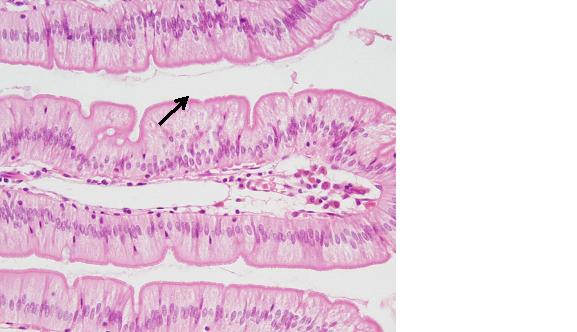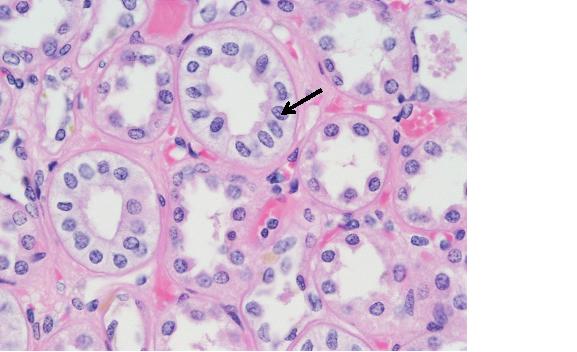Unit I: Histology I: Nervous, Epithelial & Muscular Tissues

- 1.
Identify the specific tissue type that has the following characteristics: Intercalated Discs, Striations and a Branched arrangement of cells.
- A.
Cardiac Muscle
- B.
Skeletal Muscle
- C.
Smooth Muscle
Correct Answer
A. Cardiac MuscleExplanation
Cardiac muscle is the correct answer because it is the only tissue type that possesses all the given characteristics. Intercalated discs are unique to cardiac muscle and allow for synchronized contraction. Striations are also present in cardiac muscle, which are the result of the organized arrangement of contractile proteins. Additionally, cardiac muscle cells are branched, allowing for efficient communication and coordination of contractions. Skeletal muscle has striations but does not have intercalated discs or a branched arrangement, while smooth muscle lacks both striations and intercalated discs.Rate this question:
-
- 2.
Identify the structure at the pointer:
Correct Answer
Striation
Striations
striation
striationsExplanation
The given answer options consist of variations of the word "striation" and "striations". These terms typically refer to a series of parallel lines or grooves on a surface. The variations in capitalization (lowercase and uppercase) indicate the use of singular and plural forms of the word. Therefore, the correct answer is a combination of both singular and plural forms of "striation".Rate this question:
- 3.
The Study of tissues is called what?
- A.
Cytology
- B.
Histology
- C.
Anatomy
- D.
Physiology
Correct Answer
B. HistologyExplanation
Histology is the correct answer because it is the study of tissues. It involves examining the structure, composition, and function of different types of tissues in organisms. Cytology, on the other hand, is the study of cells, while anatomy focuses on the structure of organisms, and physiology deals with the functions of living systems.Rate this question:
-
- 4.
Identify the specific tissue below:
Correct Answer
stratified squamous epithelium
Stratified Squamous EpitheliumExplanation
The specific tissue being identified is stratified squamous epithelium. This type of tissue consists of multiple layers of flat, scale-like cells that line surfaces exposed to wear and tear, such as the skin and the lining of the mouth and esophagus. Stratified squamous epithelium provides protection against mechanical stress, abrasion, and pathogens. It is characterized by its stratified nature, meaning it has multiple layers of cells, and its squamous shape, meaning the cells are flat and scale-like.Rate this question:
- 5.
Where would you find the tissue below:
Correct Answer
brain and spinal cord
Brain and Spinal Cord
Brain & Spinal Cord
Brain & spinal cordExplanation
The correct answer is brain and spinal cord, Brain and Spinal Cord, Brain & Spinal Cord, Brain & spinal cord. These options all refer to the same location, which is where the given tissue can be found. The brain and spinal cord are part of the central nervous system and are responsible for coordinating and controlling bodily functions.Rate this question:
- 6.
Mucus secreting cells of some epithelial tissues are termed what?
- A.
Mucin Cells
- B.
Simple Columnar Epithelial Cells
- C.
Intercalated Cells
- D.
Goblet Cells
Correct Answer
D. Goblet CellsExplanation
Goblet cells are the mucus-secreting cells found in some epithelial tissues. They are named after their goblet-like shape and are responsible for producing and secreting mucus, which helps in lubricating and protecting the epithelial surfaces. These cells are commonly found in the respiratory and digestive tracts, where their mucus production aids in trapping and removing foreign particles, as well as in the production of protective barriers. Therefore, the correct answer is Goblet Cells.Rate this question:
-
- 7.
Epithelial tissues are classified based on cell shape and number of layers.
- A.
True
- B.
False
Correct Answer
A. TrueExplanation
Epithelial tissues are indeed classified based on cell shape and the number of layers. This classification system helps in identifying and categorizing different types of epithelial tissues found in the body. The shape of the cells can be squamous (flat and thin), cuboidal (cube-shaped), or columnar (tall and rectangular). The number of layers can be either simple (single layer) or stratified (multiple layers). This classification system is important as it helps in understanding the structure and function of different epithelial tissues in various organs and tissues of the body.Rate this question:
-
- 8.
Goblet cells secrete wet mucus and are found in simple cuboidal epithelium.
- A.
True
- B.
False
Correct Answer
B. FalseExplanation
The statement is false because goblet cells secrete sticky mucus, not wet mucus. Additionally, goblet cells are found in simple columnar epithelium, not simple cuboidal epithelium.Rate this question:
-
- 9.
Identify the cell at the pointer:
Correct Answer
Goblet Cells
goblet cells
Goblet cells
goblet cellExplanation
The correct answer is "Goblet Cells, goblet cells, Goblet cells, goblet cell." The question asks to identify the cell at the pointer, and the given options all mention "goblet cells" in different variations of capitalization and singular/plural forms. Therefore, the correct answer is any of the options that mention "goblet cells" in any of the given variations.Rate this question:
- 10.
Identify the structure at the pointer:
Correct Answer
Interclalated Disc
Intercalatated disc
intercalated disc
Intercalated Discs
Intercalated discs
intercalated discs - 11.
Nervous tissue consists of two cell types neuroglia and neurons.
- A.
True
- B.
False
Correct Answer
A. TrueExplanation
The statement is true because nervous tissue is indeed composed of two main cell types: neuroglia and neurons. Neuroglia cells provide support and protection to neurons, while neurons are responsible for transmitting electrical signals and carrying out the functions of the nervous system. Therefore, the given answer is correct.Rate this question:
-
- 12.
What is the region at the pointer termed?
- A.
Basement Membrane
- B.
Apical Surface
- C.
Lateral Surface
- D.
Basale Surface
Correct Answer
B. Apical SurfaceExplanation
The region at the pointer is termed as the apical surface. The apical surface is the topmost surface of a cell or tissue that is exposed to the external environment or a body cavity. It is often specialized to perform specific functions such as absorption, secretion, or protection. In epithelial tissues, the apical surface is typically lined with microvilli or cilia to increase surface area or aid in movement, respectively.Rate this question:
-
- 13.
Smooth Muscle is found surrounding/lining hollow organs.
- A.
True
- B.
False
Correct Answer
A. TrueExplanation
Smooth muscle is a type of muscle tissue that is found in the walls of hollow organs such as the stomach, intestines, bladder, and blood vessels. It is responsible for the involuntary movements of these organs, such as the contraction and relaxation needed for digestion, urination, and blood flow. The presence of smooth muscle allows these organs to change their shape and size to accommodate various functions. Therefore, the statement that smooth muscle is found surrounding or lining hollow organs is true.Rate this question:
-
- 14.
The function of simple squamous epithelium is protection.
- A.
True
- B.
False
Correct Answer
B. False -
- 15.
Simple Cuboidal Epithelium can be found in both glands and kidney glomeruli (tubules).
- A.
True
- B.
False
Correct Answer
A. TrueExplanation
Simple cuboidal epithelium is a type of epithelial tissue that consists of a single layer of cube-shaped cells. It is found in various parts of the body, including glands and the tubules of the kidneys. In glands, simple cuboidal epithelium lines the ducts and helps in the secretion of substances. In the kidney glomeruli, it forms the lining of the tubules and aids in the filtration and reabsorption of substances. Therefore, the statement that simple cuboidal epithelium can be found in both glands and kidney glomeruli (tubules) is true.Rate this question:
-
- 16.
Identify the structure at the pointer:
Correct Answer
Nucleus
nucleusExplanation
The structure at the pointer is the nucleus. The repetition of the word "nucleus" suggests that it is being emphasized or reiterated.Rate this question:
- 17.
Identify the large cell shown in the field of view below:
Correct Answer
Neuron
neuronExplanation
The large cell shown in the field of view is a neuron. A neuron is a specialized cell that is responsible for transmitting information in the nervous system. It has a unique structure with a cell body, dendrites, and an axon. Neurons are the building blocks of the nervous system and play a crucial role in transmitting electrical signals and facilitating communication between different parts of the body.Rate this question:
- 18.
Identify the structure at the pointer:
Correct Answer
soma
Soma
Cell Body
cell bodyExplanation
The correct answer is "soma, Soma, Cell Body, cell body." The question asks to identify the structure at the pointer, and the answer provides multiple possible options. "Soma" and "cell body" both refer to the same structure in a neuron, which is the main part of the neuron that contains the nucleus and other organelles. The variations in capitalization are likely included to account for different ways the term may be written or referred to.Rate this question:
- 19.
Identify the function of the tissue below:
- A.
Produce body movements
- B.
Propel and contract the heart
- C.
Propel/move substances through hollow organs
- D.
Cell to cell communication
Correct Answer
C. Propel/move substances through hollow organsExplanation
The function of the tissue described in the answer is to propel/move substances through hollow organs. This suggests that the tissue is involved in the movement of fluids or materials through structures such as blood vessels, intestines, or ducts. It implies that the tissue has specialized cells or structures that aid in the transportation of substances within the body.Rate this question:
-
- 20.
Epithelial tissues have large amounts of space between cells.
- A.
True
- B.
False
Correct Answer
B. FalseExplanation
Epithelial tissues do not have large amounts of space between cells. In fact, epithelial tissues are characterized by cells that are tightly packed together with very little space between them. This close arrangement allows epithelial tissues to form protective barriers and linings in the body, such as the skin and the lining of organs. Therefore, the correct answer is False.Rate this question:
-
Quiz Review Timeline +
Our quizzes are rigorously reviewed, monitored and continuously updated by our expert board to maintain accuracy, relevance, and timeliness.
-
Current Version
-
May 15, 2023Quiz Edited by
ProProfs Editorial Team -
Jan 06, 2012Quiz Created by
Sutton_anatomy
 Back to top
Back to top




.jpg)





.jpg)

.jpg)